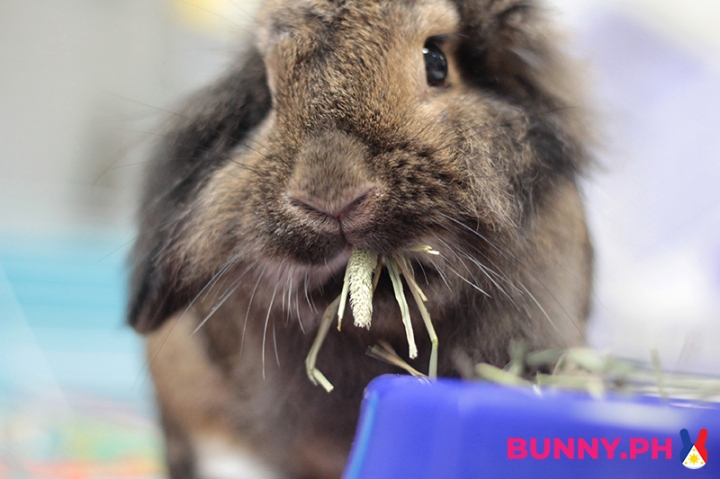Contrary to what people in the Philippines know, pellets are NOT supposed to be a rabbit’s staple food. Instead, rabbits should be fed with unlimited hay. Hay provides them with all the nutrients and fiber that they need. When pellets are a rabbit’s staple food, chances are they become more prone to certain illnesses.

A rabbit’s diet should be at least 80% hay, 10% vegetables, 5% pellets, and 5% treats.
Here’s a simple guide to help you understand a rabbit’s basic diet:
- 6 months and below: Unlimited alfalfa hay and unlimited pellets
- 3 months: Introduce vegetables one at a time and in small quantities
- 7 months: Introduce other types of hay such as timothy hay, while gradually decreasing intake of pellets and alfalfa hay, and introduce fruits and treats but only to be given occasionally with maximum of 1-2 tablespoons a day
- 1 year old and above: Unlimited timothy hay, grass hay or oat hay, while pellets should be a maximum of ½ cup a day, and vegetables increased to at least 2 cups a day

Alfalfa hay is best for young rabbits as it is rich in protein, calcium and fat – best for growing babies. Too much of these nutrients are bad for adult rabbits, that’s why it’s recommended to transition to timothy hay when rabbits reach 1 year old. When a rabbit reaches adulthood, his or her primary food should be timothy hay or any other grass hay such as orchard hay. Pellets should be only minimal, as well as vegetables and fruits.
When introducing a new vegetable or fruit, give them one at a time and in very small quantities. Check for any signs of diarrhea and discontinue giving it at the first signs. Remember to check if the vegetable or fruit is rabbit-friendly before giving it to your rabbit.

Local veggies and fruits that are safe for rabbits:
- Apple
- Arugula
- Banana
- Basil
- Bok Choy
- Carrot (more of a treat, than a staple veggie)
- Cilantro (Wansoy)
- Dill
- Fennel
- Mango
- Melon
- Mint
- Mustard Greens (Mustasa)
- Papaya
- Parsley (not to be fed everyday)
- Pineapple
- Romaine Lettuce (NOT Iceberg!)
- Watercress
- Wheatgrass
Under any circumstances, please DO NOT feed the following foods to your rabbit as they might be fatal:
- Coffee Beans
- Chocolate
- House Plants (Since most are toxic to rabbits)
- Iceberg Lettuce
- Onions
For the best pellets, choose one that is high in fiber (at least 18%). Avoid those with nuts, fruits and other treats if you can, or at least separate these and treat them as your rabbit’s occasional rewards. Alfalfa hay-based pellets are best for young rabbits, while timothy hay-based ones are best for adult rabbits. When changing your type or brand of pellets, it’s important to first mix the new and the old ones first. Then, gradually decrease the amount of the old pellets for your rabbit to properly transition to the new pellets.
Aside from these, rabbits also need unlimited access to clean water. You can either offer in a bowl or in a drinking bottle, whichever your little one is used to.
For a list of rabbit-friendly fruits and vegetables commonly found in your local supermarket and grocery stores, please click here.
For more information on proper rabbit diet, you can also visit http://rabbit.org/faq-diet/
Giving your little one the proper food she/he needs might seem a little complicated, but it definitely will be worth it in the long run. A properly fed rabbit will not only be a healthy one, but also he/she will grow into a loving companion for many years.
***
As we’re not able to check replies and comments as frequently as we’d like to, feel free to get in touch with our Instagram account @bunniespiggiesqc or send an email to rabbitomart@gmail.com


HI! may I know where you buy your Hay?
LikeLike
Hi! We get ours from ilovemypets.ph 🙂
LikeLike
LOVE YOUR SITE 🙂 So happy to find a Filipino page for bunny tips
LikeLike
Thank you! 🙂
LikeLike
can’t click the list for stores where we can buy hay
LikeLike
Here’s the link https://bunnyph.wordpress.com/2016/09/19/store-guide/ 🙂
LikeLike
Hello. I don’t really know much about bunnies. I fed mine with romaine lettuce and just read that I shouldn’t (i think mine is less than 3 months old…) Oh no. Any tips?
LikeLike
So sorry for the delayed response. Just observe for now and only feed f
LikeLike
..feed foods that are safe for him 🙂
LikeLike
Hi 🙂 where to buy a water container for them?
LikeLike
Hi! We just get the generic water bottles from any pet store 🙂
LikeLike
Hi Frances! If you’re still looking for water bottles and other rabbit related products, we’ve recently put up our own online rabbit shop. Hop on over at https://rabbitomart.com/ 😀
LikeLike